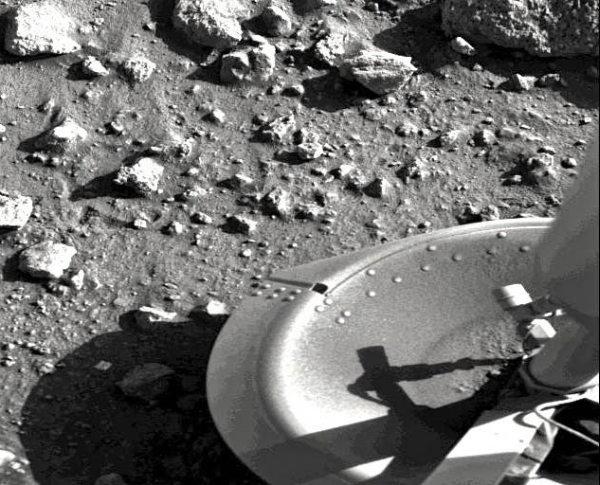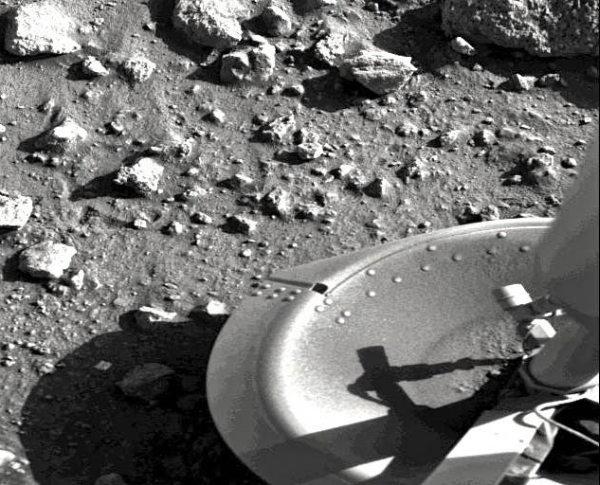"Vikings" did not find life on Mars, because pre killed her
 Bashny.Net
Bashny.Net

"Viking-1" and "Viking-2" landed on the red planet 36 years ago, had a miniature laboratory, which had to analyze Martian soil for the presence of traces of life in it. More precisely, as it turned out, their zeroing in on the ground in search of traces of life on earth ....
In one of the experiments microlaboratory rovers Martian soil mixed with water with various micronutrients and got a sharp increase (in the experimental chamber), the concentration of oxygen, carbon dioxide and some nitrogen. Such a process was not observed in the control samples, previously sterilized by heat. Exactly the same results were obtained by the "Viking-2" landed in 6400 km from the first machine. However, all this was considered irrelevant because another tool microlaboratory designed to detect traces of organic matter in samples of Martian soil, could not do it. "Building blocks" of life in the form in which they imagine the creators of "Viking" is definitely absent on Mars. Several researchers have put forward in connection with the assumption that it was necessary to look for "brick" Martian, rather than earthly life.
Experiment Labeled Release, which was obtained by increasing the concentration of oxygen and carbon dioxide, as it was necessary to explain something, and in the 1970s it was credited to the presence in the soil of a hypothetical hydrogen peroxide is extremely unstable compound able to exist relatively short time. When mixed with liquids it decomposed to oxygen and water (?). But laboratory experiments conducted on Earth, could not get a result from the rocks, mixed with hydrogen peroxide. In 2007, Joop Houtkuper (Joop Houtkooper) from the University of Giessen (Germany) suggested that in reality tests microlaboratory "Viking" in general could not find traces of Martian organic matter, as previously destroyed relevant microorganisms. According to his hypothesis, the Martian bacteria had a water-hydrogen peroxide metabolism, and he has not made a "favorable", according to developers microlaboratory "chicken soup", which is poured soil samples. Furthermore, contact with water just killed bacteria with a high content of hydrogen peroxide.

First picture, sent to Earth after landing "Viking 1" (Here and below, NASA photo.)
At least the growth of oxygen and carbon dioxide has been caused by the destruction of cell membrane and release their contents rapidly oxidized in the experimental chamber. Traces of life in the subsequent tests could not be found, because life has been previously killed by spraying with water, is designed to stimulate its manifestations. This occurred primarily because the tests were "incarcerated" under the search for life only Earth-like - that in respect of Mars was somewhat impractical, noted scientist.
Then the "Phoenix" and does discovered on Mars perchlorates in the soil. More precisely, they should be (chloromethane and dichloromethane) found the same "Vikings", that's just, as in the case of water, the Americans found in the lunar soil, it was immediately decided that this contamination of terrestrial origin (chloromethane in the world then was widely used as a coolant ), and not at all traces of Martian perchlorates.
The presence of perchlorate, could become a serious oxidants could be a trigger for the destruction of Martian life in analyzing soil samples, even if it is a copy of the earth. At low temperatures, the presence of perchlorate did not affect the content of organic matter, but when heated perchlorates actively react with organic matter, it destroys it. Moreover, as a result of such reactions, as shown by experiments conducted after the findings of "Phoenix", released just chloromethane - like that found the "Vikings».
Finally, as we have already mentioned, a new analysis of data on the ground, to investigate the "Viking", has shown that it is too complicated to be able to talk about his non-biogenic origin. So that bacterial life on Mars is quite possible, but to seek appropriate methods of it, we have not yet learned.
What to do? How to organize the search for extraterrestrial life so as to provide concrete evidence of it, without knowing in advance how they will look like? If not only biology, but also the chemical composition of the soil of Mars as a whole is very unusual, and not knowing them in detail in advance, it is difficult to conduct a test that would prove unequivocally the existence of life on the Red Planet?
A new attempt rover Curiosity, which this August will try to find traces of life on Mars, is designed in a completely different way: instead of experiments that can give results only if we think of the possibility of such an outcome, nyneny approach more focused on the observation.
The fact is that in recent years has attracted the attention of researchers strange thing - very low lifetime of methane in the Martian atmosphere and its geographically uneven distribution (over certain areas of the planet it anymore, but somewhere there is almost no). According to the calculations of researchers from the Sorbonne (France) to methane could be distributed in the atmosphere with violent winds (as on Mars) is uneven, it should have a lifetime of no more than 200 days. The standard process of decomposition of methane in the Earth's atmosphere is a photochemical. One problem - it requires several centuries. So, something destroys methane Mars hundreds of times faster than on Earth, and then only at the surface. Although the French themselves have suggested that this is the result of oxidation of soil perchlorates, in the scientific community read it once appeared legitimate question: how perchlorates have not responded (in millions of years of its existence) and methane without reserve, because of the current processes that could "turn out" perchlorates in the Martian soil, nothing is known.

"Vikings" tried to encourage the development of Martian bacteria in ways that would have ruined the life of Earth-like, and a hypothetical vodoperoksidnuyu. Taken into account whether a lesson or we will again explore glassware hammer?
At the same time there was a reasonable assumption, which can be called a hypothesis CH4 + O2 → HCHO + H2O (methane is oxidized by oxygen, forms formaldehyde and water). In other words, someone (Chemotroph) oxidizes methane at the surface, while other bacteria produce it - otherwise methane with its ultrashort-lived long ago on Mars would have ended, for his abiogenic operating time is estimated to be very low.
The main thing - ESA probe were found in the Martian atmosphere formaldehyde is formed in such a hypothetical reaction. Abiotic mechanism of production of formaldehyde in the conditions of Mars is not yet known, which gives some hope for its biogenic origin.
How did participants find such a hypothetical cycle of methane oxidation? There is a way. On Earth, bacteria that produce methane, used in their molecules isotope carbon-12, preferring to "ignore" the carbon-13. The dominance of carbon-12 in the soil of the fourth planet would indicate that life on Mars - at least in the form of bacteria - still exists.
Tags
See also
People are false, because they found the key
10 stupid attempts to prove the existence of aliens
What they see on Mars
Why colonize Mars is difficult - and that this should be done
We were on the road easier, because we can always play the fool
Mysteries of Mars
"Fox stayed with us because he had come to look at the Maidan. It Maidan came to us because they came fox."
14 signs that you meet women on which to MARRY

















